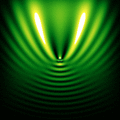Mie scattering facts for kids

Have you ever wondered why clouds look white or grey, or why fog appears thick and hazy? The answer often involves something called Mie scattering. This is a special way that light bounces off, or scatters, from tiny objects. It helps us understand many everyday things we see around us.
Contents
What is Mie Scattering?
Mie scattering is a scientific idea that explains how light behaves when it hits particles. It was named after a German physicist, Gustav Mie, who developed this theory. This idea is very useful because it works for all different wavelengths of light and for objects of all sizes.
How Light Scatters
When light travels, it can hit tiny things in its path. When it does, the light can change direction. This change in direction is called scattering. Think of it like throwing a ball at a wall. The ball bounces off and goes in a new direction. Light does something similar when it hits small particles.
Mie Scattering vs. Rayleigh Scattering
There are different ways light can scatter. One common type is Rayleigh scattering. This happens when light hits very tiny particles. These particles are much smaller than the light's wavelength. Rayleigh scattering is why the sky looks blue. It also causes sunsets to look red.
Mie scattering is different. It happens when light hits particles that are about the same size as the light's wavelength. It also works for particles that are even larger. This is why it's so useful for understanding things like clouds.
Why Clouds Look White
Clouds are made of tiny water droplets or ice crystals. These droplets are often similar in size to the wavelengths of visible light. When sunlight hits these droplets, Mie scattering occurs. Unlike Rayleigh scattering, Mie scattering spreads all colors of light almost equally.
Because all colors are scattered equally, the light that reaches our eyes looks white or grey. This is why clouds usually appear white. If they are very thick, less light gets through, making them look grey or even dark.
Other Examples of Mie Scattering
Mie scattering helps explain other natural events too.
- Fog and Haze: Fog and haze are made of tiny water droplets or pollution particles. These particles scatter light using Mie scattering. This makes it hard to see far away.
- Milk: Milk looks white because of tiny fat particles floating in it. These particles scatter light through Mie scattering, making the milk appear white.
- Paint: Many white paints use tiny particles of titanium dioxide. These particles scatter light using Mie scattering, giving the paint its white color.
Images for kids
See also
 In Spanish: Difusión de Mie para niños
In Spanish: Difusión de Mie para niños



